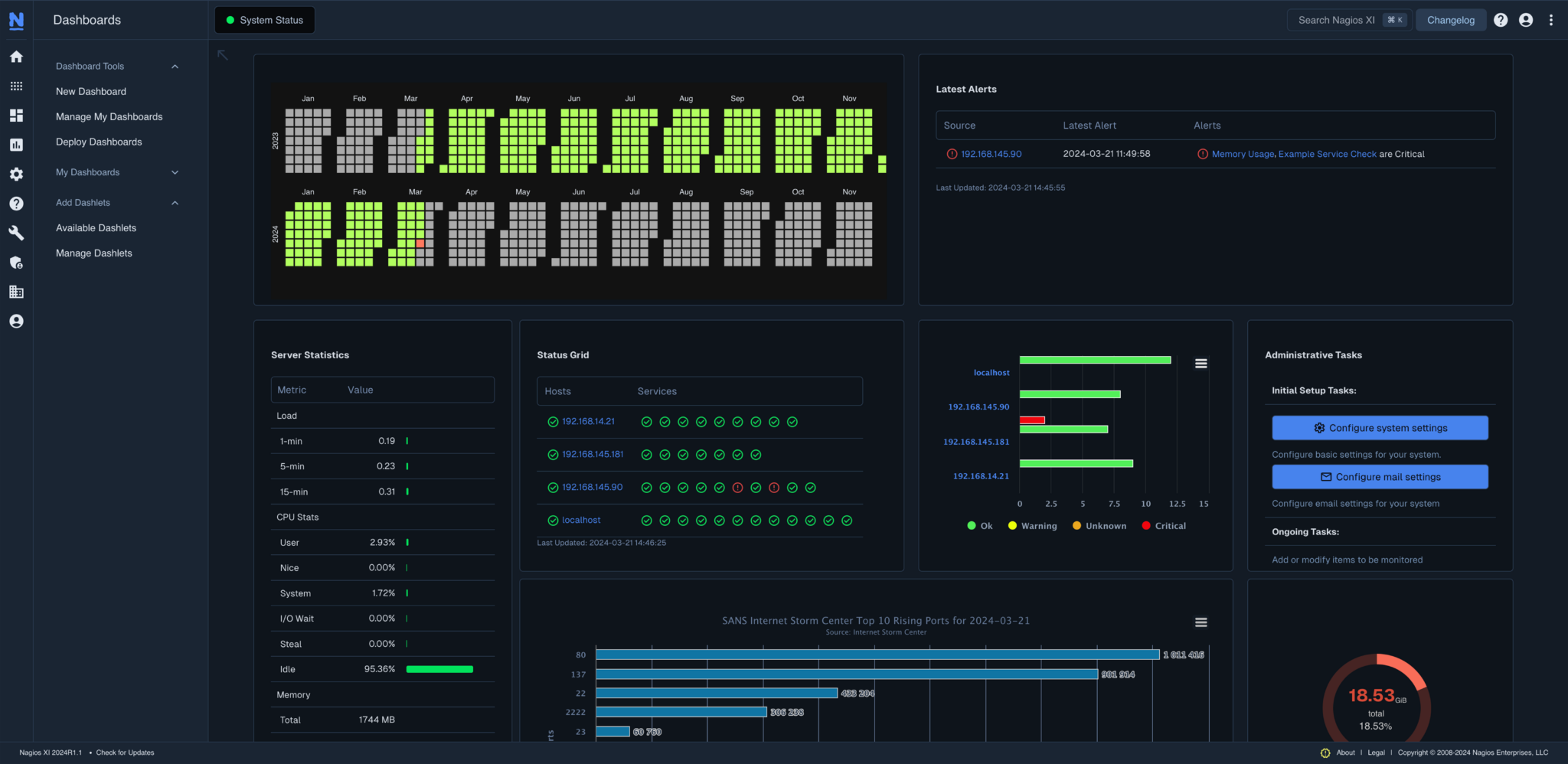

Nagios - Open-source Monitoring Solution
✅ Enterprise-Grade Monitoring – Provides real-time monitoring for IT infrastructure, applications, networks, and security.
✅ Open-Source & Extensible – Highly customizable with thousands of plugins and integrations.
✅ Proactive Alerting & Incident Response – Detects issues before failures occur, reducing downtime.
✅ Log Management & Compliance Support – Helps meet ISO 27001, PCI DSS, GDPR, HIPAA, NIST, SOC 2, and more.
✅ Scalable & Distributed Architecture – Supports large IT environments with high availability.
✅ Security & Threat Detection – Monitors logs, detects anomalies, and prevents unauthorized access.
✅ Cloud & Hybrid Monitoring – Supports AWS, Azure, GCP, and on-premises environments.
✅ Comprehensive Reporting & Dashboards – Provides insights for audits, compliance, and performance tuning.
Would you like assistance with Nagios setup, best practices, or integrations? Call meeee 😊
What is Nagios?
Nagios is an enterprise-grade, open-source monitoring solution designed to monitor the health, performance, and availability of IT infrastructure, networks, servers, applications, and cloud environments. It helps organizations identify issues before they cause failures, ensuring system uptime and optimal performance.
Nagios offers both open-source (Nagios Core) and enterprise solutions (Nagios XI, Nagios Log Server, Nagios Network Analyzer) with advanced monitoring, reporting, and alerting capabilities.
Key Features of Nagios
✅ Comprehensive Monitoring
- Monitors network devices (routers, switches, firewalls), servers (Linux, Windows), applications, cloud services, databases, and hardware components.
- Supports monitoring via SNMP, SSH, WMI, NRPE, and custom plugins.
✅ Scalability & High Availability
- Capable of monitoring thousands of hosts and services.
- Supports distributed monitoring to reduce performance bottlenecks.
✅ Automated Alerting & Incident Response
- Sends real-time notifications via email, SMS, Slack, PagerDuty, and webhooks.
- Supports event escalation and automated remediation actions.
✅ Custom Plugins & Extensibility
- Thousands of community and enterprise plugins for enhanced monitoring.
- API integration with Ansible, Prometheus, Grafana, ELK Stack, and cloud platforms.
✅ Log Monitoring & Event Correlation
- Nagios Log Server centralizes and analyzes logs for anomaly detection.
- Detects security threats, unauthorized access, and system failures.
✅ Dashboards & Custom Reports
- Provides real-time dashboards with customizable widgets.
- Generates performance trends, SLA reports, and compliance documentation.

Use Cases of Nagios
📌 1. IT Infrastructure Monitoring
- Ensures uptime of servers, storage systems, virtual machines, and cloud environments.
- Tracks CPU, memory, disk usage, and network traffic.
📌 2. Network Monitoring & Security
- Monitors bandwidth usage, latency, and traffic anomalies.
- Detects DDoS attacks, unauthorized access, and firewall misconfigurations.
📌 3. Cloud & Hybrid Infrastructure Monitoring
- Supports AWS, Azure, Google Cloud, OpenStack monitoring.
- Provides visibility into multi-cloud and hybrid environments.
📌 4. Application & Database Performance Monitoring
- Monitors web applications, APIs, and backend databases.
- Ensures fast response times and service availability.
📌 5. Log Analysis & Compliance Monitoring
- Centralizes and analyzes logs to meet GDPR, ISO 27001, PCI DSS requirements.
- Detects unusual login attempts, file modifications, and system failures.
📌 6. Business Service Monitoring (BSM)
- Links IT infrastructure health to business-critical applications.
- Helps reduce downtime and optimize IT operations.
Benefits of Using Nagios
🎯 1. Enterprise-Grade Open Source Monitoring
- No licensing fees for Nagios Core (free version).
- Enterprise features available in Nagios XI with support and scalability.
🎯 2. Proactive IT Issue Resolution
- Detects problems before they escalate.
- Reduces downtime and operational risks.
🎯 3. Highly Customizable & Extensible
- Thousands of plugins and integrations.
- Works with automation and DevOps tools (Ansible, Kubernetes, Terraform, etc.).
🎯 4. Centralized Monitoring & Reporting
- Provides a unified dashboard for infrastructure visibility.
- Generates compliance reports for auditing and security.
🎯 5. Supports Compliance & Security Standards
- Helps meet ISO 27001, PCI DSS, NIST, GDPR, SOC 2 by tracking logs, security incidents, and uptime.
🎯 6. Scalable & Distributed Architecture
- Monitors large IT environments and data centers.
- Supports redundancy and failover mechanisms.
Who Uses Nagios?
- Enterprises & SMEs – For server, application, and network monitoring.
- Financial Institutions – Ensures uptime and security for banking applications.
- Government & Healthcare – Complies with security and availability standards.
- Cloud Providers & Data Centers – Monitors multi-cloud and hybrid environments.
- E-commerce & SaaS Companies – Ensures website and service reliability.
Conclusion
Nagios is a powerful, scalable, and customizable IT monitoring solution suitable for enterprise environments. Whether you need to monitor networks, servers, applications, or security threats, Nagios provides real-time alerts, log analysis, and automated remediation to ensure high availability and compliance.
Compliance Achievable with Nagios & Relevant Requirements
Nagios helps organizations achieve compliance with various security, IT governance, and data protection standards by providing real-time monitoring, log management, security alerts, and system performance tracking. Below are key compliance frameworks that can be supported using Nagios, along with relevant requirements and why Nagios is useful for each.
1. ISO 27001 (Information Security Management System - ISMS)
| ISO 27001 Clause | Requirement | How Nagios Helps |
|---|---|---|
| A.12.1.2 | Monitoring and logging of IT systems | Tracks system logs, performance, and security incidents. |
| A.12.4.1 | Event logging | Logs user activities, system changes, and security breaches. |
| A.16.1.3 | Incident response | Sends real-time alerts for system failures, unauthorized access, and security threats. |
| A.14.2.7 | Secure development monitoring | Monitors security of development and staging environments. |
✅ Why?
Nagios ensures continuous monitoring, logging, and incident detection, which are core requirements of ISO 27001.
2. PCI DSS (Payment Card Industry Data Security Standard)
| PCI DSS Requirement | Requirement | How Nagios Helps |
|---|---|---|
| Req. 10.5 | Secure log storage & monitoring | Nagios logs and tracks system access to ensure auditability. |
| Req. 11.4 | Intrusion detection & prevention | Detects unauthorized access and unusual network activity. |
| Req. 12.10.5 | Continuous monitoring & alerts | Provides real-time alerts for security events. |
✅ Why?
Nagios helps financial institutions meet PCI DSS compliance by monitoring security logs, detecting intrusions, and sending alerts for suspicious activity.
3. GDPR (General Data Protection Regulation)
| GDPR Article | Requirement | How Nagios Helps |
|---|---|---|
| Art. 32 | Security of processing | Monitors access logs, system performance, and anomalies. |
| Art. 33 | Data breach detection & notification | Detects security incidents and enables rapid response. |
| Art. 25 | Privacy by design | Ensures IT infrastructure remains secure through proactive monitoring. |
✅ Why?
Nagios helps organizations monitor and secure IT environments to comply with GDPR's data protection requirements.
4. HIPAA (Health Insurance Portability and Accountability Act)
| HIPAA Security Rule | Requirement | How Nagios Helps |
|---|---|---|
| 164.308(a)(1)(ii)(D) | Information system activity review | Monitors electronic health record (EHR) access logs. |
| 164.312(b) | Audit controls | Logs access and system events for compliance. |
| 164.312(c)(1) | Data integrity monitoring | Detects unauthorized access or modification of health data. |
✅ Why?
Nagios helps healthcare providers track access to sensitive health information, ensuring compliance with HIPAA security rules.
5. NIST 800-53 (National Institute of Standards and Technology - Security Controls)
| NIST Control ID | Requirement | How Nagios Helps |
|---|---|---|
| AU-6 | Audit log review | Stores and analyzes system logs for anomaly detection. |
| SI-4 | System monitoring | Monitors infrastructure security and detects threats. |
| CA-7 | Continuous security monitoring | Identifies system vulnerabilities and tracks changes. |
✅ Why?
Nagios helps organizations align with NIST’s cybersecurity framework by providing audit logs, continuous monitoring, and automated alerts.
6. SOC 2 (Service Organization Control 2 - Security & Availability)
| SOC 2 Trust Principle | Requirement | How Nagios Helps |
|---|---|---|
| Security | Protection from unauthorized access | Detects security threats and failed login attempts. |
| Availability | Ensures uptime and service reliability | Monitors servers, applications, and network health. |
| Processing Integrity | Ensures IT operations function correctly | Tracks application performance and service integrity. |
✅ Why?
Nagios supports SOC 2 compliance by ensuring security, availability, and system integrity through proactive monitoring.
7. ISO 22301 (Business Continuity Management - BCMS)
| ISO 22301 Clause | Requirement | How Nagios Helps |
|---|---|---|
| 8.4.3 | Incident monitoring & response | Detects and alerts on system failures or security incidents. |
| 8.5.1 | Business continuity monitoring | Ensures uptime of critical IT infrastructure. |
| 9.1.1 | Performance monitoring | Tracks system health to prevent disruptions. |
✅ Why?
Nagios helps organizations implement business continuity strategies by detecting outages, failures, and security threats.
8. CIS Controls (Center for Internet Security)
| CIS Control | Requirement | How Nagios Helps |
|---|---|---|
| CIS Control 3 | Continuous vulnerability management | Detects and alerts on system vulnerabilities. |
| CIS Control 6 | Maintenance, monitoring, and analysis of audit logs | Logs system events and security incidents. |
| CIS Control 8 | Malware defenses | Monitors suspicious activity and unauthorized access. |
✅ Why?
Nagios enables CIS compliance by providing logging, monitoring, and security event tracking.
9. ITIL (Information Technology Infrastructure Library)
| ITIL Process | Requirement | How Nagios Helps |
|---|---|---|
| Incident Management | Detect and resolve IT incidents | Tracks system health and notifies IT teams. |
| Problem Management | Identify recurring IT issues | Provides insights into performance trends and failures. |
| Change Management | Monitor IT infrastructure changes | Detects configuration changes and unauthorized modifications. |
✅ Why?
Nagios helps IT service management teams implement ITIL best practices by ensuring continuous monitoring and quick incident response.

